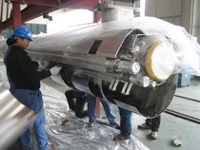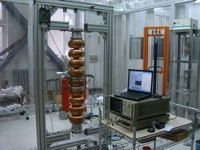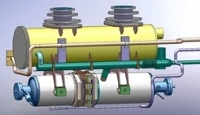 |
 |
|||||||||||||
|
|||||||||||||
|
|||||||||||||
|
The effort towards realising the International Linear Collider is being carried out by global collaboration. Such efforts focus mainly on the technology development, but other aspects such as training the younger generation, are also important to ILC community. From 7 to 18 September China hosted the Fourth International Accelerator School for Linear Colliders in Beijing at Huairou. Among 69 students from 21 countries, there were 29 students from Asia, including 15 Chinese students. Since 2005, Chinese PhD students majoring in ILC-related topics are increasing steadily, ranging from global beam dynamics, final focus, superconducting technology (such as superconducting cavity, coupler, and cryostat), positron source, damping ring, and so forth. It is very important and fruitful for the students to attend the Linear Collider Accelerator School to gain global knowledge starting from particle physics, detailed accelerator physics and technology, to concrete projects. It is also good news for China that the Chinese students ranked high in the school's final examination. In the first school, they occupied the second (IHEP), third (IHEP/Beijing University) and eighth (Tsinghua University) places in the top ten. Since the third school, Chinese students have been heading the list. The organisers believe that the students benefit greatly from active involvement in the ILC worldwide collaboration to reach these excellent study results. Every year 6.3 million students graduate from Chinese universities. A good balance of quality and quantity for Chinese human resources is very important for China’s participation in the world-scale large science collaboration like ILC. As for ILC-related technology development, through fruitful collaboration with the European X-Ray Laser Project (XFEL) hosted by DESY, IHEP (Beijing) produced a cryomodule which consists of a 12.2-metre-long outer vacuum vessel as well as its cryogenic components ("cold mass") for the prototype PXFEL1, which was successfully tested at DESY with an average accelerating gradient of more than 30 megavolts per metre. This technical advance encourages greatly the ongoing ILC-related technology development at IHEP, such as nine-cell large-grain superconducting cavities, high power couplers, test cryostats, low-level radiofrequency (RF) control, tuners and cavity surface treatment technology. The horizontal test stand programme for 1.3-GHz nine-cell superconducting cavities at IHEP is similar to some test stands in Europe and USA, but there will be a unique single-cavity test stand in Asia dedicated to 1.3-GHz nine-cell cavity studies, while the cryomodule of the Superconducting RF Test Facility (STF) at KEK contains four cavities. The aim of this programme is to master the technology to fabricate cavities with the high accelerating gradient required for the ILC with small gradient spread, to fabricate 1.3-GHz high power couplers, and the control system permitting stable operation of a cryomodule with tuner and LLRF. Based on this technology, as an application, a 60-MeV 1.3-GHz superconducting linac is foreseen at IHEP as an energy recovery linac and terahertz-test facility. Next year, from 26 to 30 March, the International Linear Collider Workshop 2010 (LCWS10 and ILC10) will be held in the Friendship Hotel, Beijing, China. Beijing, city of the 2008 Olympic Games, welcomes an active participation to this important workshop with friends from different parts of the world. Hopefully, even more progress can be reported then. -- Jie Gao |
|||||||||||||
| © International Linear Collider |




